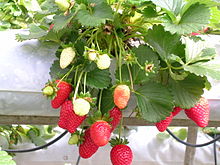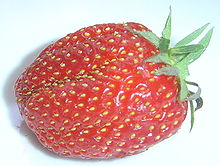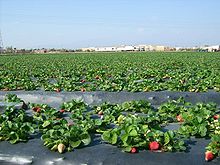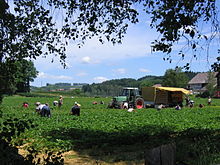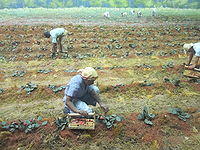- Garden strawberry
-
"Strawberry" redirects here. For other species of strawberry, see Fragaria. For other uses, see Strawberry (disambiguation).
Garden strawberry Garden strawberries grown hydroponically Scientific classification Kingdom: Plantae (unranked): Angiosperms (unranked): Eudicots (unranked): Rosids Order: Rosales Family: Rosaceae Subfamily: Rosoideae Genus: Fragaria Species: F. × ananassa Binomial name Fragaria × ananassa
DuchesneThe garden strawberry, Fragaria × ananassa, is a hybrid species that is cultivated worldwide for its fruit, the (common) strawberry. The fruit (which is not actually a berry, but an aggregate accessory fruit) is widely appreciated for its characteristic aroma, bright red color, juicy texture, and sweetness. It is consumed in large quantities, either fresh or in prepared foods such as preserves, fruit juice, pies, ice creams, and milkshakes. Artificial strawberry aroma is also widely used in all sorts of industrialized food products.
The garden strawberry was first bred in Brittany, France, about 1740 via a cross of Fragaria virginiana from eastern North America, which was noted for its flavor, and Fragaria chiloensis from Chile and Argentina brought by Amédée-François Frézier, which was noted for its large size.[1]
Cultivars of Fragaria × ananassa have replaced, in commercial production, the woodland strawberry, which was the first strawberry species cultivated in the early 17th century.[2]
The strawberry is, in technical terms, an aggregate accessory fruit, meaning that the fleshy part is derived not from the plant's ovaries but from the "receptacle" that holds the ovaries.[3] Each apparent "seed" (achene) on the outside of the fruit is actually one of the ovaries of the flower, with a seed inside it.[3] In both culinary and botanical terms, the entire structure is called a "fruit".[3]
Contents
Cultivation
Fragaria × ananassa 'Gariguette,' a cultivar grown in southern France See also: the breeding of strawberries
See also: the breeding of strawberriesStrawberry cultivars vary widely in size, color, flavor, shape, degree of fertility, season of ripening, liability to disease and constitution of plant.[4] Some vary in foliage, and some vary materially in the relative development of their sexual organs. In most cases, the flowers appear hermaphroditic in structure, but function as either male or female.[5] For purposes of commercial production, plants are propagated from runners (stolons) and, in general, distributed as either bare root plants or plugs. Cultivation follows one of two general models, annual plasticulture[6] or a perennial system of matted rows or mounds.[7] A small amount of strawberries are also produced in greenhouses during the off season.[8]
The bulk of modern commercial production uses the plasticulture system. In this method, raised beds are formed each year, fumigated, and covered with plastic to prevent weed growth and erosion. Plants, usually obtained from northern nurseries, are planted through holes punched in this covering, and irrigation tubing is run underneath. Runners are removed from the plants as they appear, to encourage the plants to put most of their energy into fruit development. At the end of the harvest season, the plastic is removed and the plants are plowed into the ground.[6][9] Because strawberry plants more than a year or two old begin to decline in productivity and fruit quality, this system of replacing the plants each year allows for improved yields and denser plantings.[6][9] However, because it requires a longer growing season to allow for establishment of the plants each year, and because of the increased costs in terms of forming and covering the mounds and purchasing plants each year, it is not always practical in all areas.[9]
The other major method, which uses the same plants from year to year growing in rows or on mounds, is most common in colder climates.[6][7] It has lower investment costs, and lower overall maintenance requirements.[7] Yields are typically lower than in plasticulture.[7]
A third method uses a compost sock. Plants grown in compost socks have been shown to produce significantly higher oxygen radical absorbance capacity (ORAC), flavonoids, anthocyanins, fructose, glucose, sucrose, malic acid, and citric acid than fruit produced in the black plastic mulch or matted row systems.[10] Similar results in an earlier 2003 study conducted by the US Dept of Agriculture, at the Agricultural Research Service, in Beltsville Maryland, confirms how compost plays a role in the bioactive qualities of two strawberry cultivars.[11]
Strawberries are often grouped according to their flowering habit.[4][12] Traditionally, this has consisted of a division between "June-bearing" strawberries, which bear their fruit in the early summer and "ever-bearing" strawberries, which often bear several crops of fruit throughout the season.[12] Research has shown recently[when?] that strawberries actually occur in three basic flowering habits: short-day, long-day, and day-neutral. These refer to the day-length sensitivity of the plant and the type of photoperiod that induces flower formation. Day-neutral cultivars produce flowers regardless of the photoperiod.[13]
Strawberries may also be propagated by seed, though this is primarily a hobby activity, and is not widely practiced commercially. A few seed-propagated cultivars have been developed for home use, and research into growing from seed commercially is ongoing.[14] Seeds (achenes) are acquired either via commercial seed suppliers, or by collecting and saving them from the fruit.
Strawberries can also be grown indoors in strawberry pots.
Manuring and harvesting
Most strawberry plants are now fed with artificial fertilizers, both before and after harvesting, and often before planting in plasticulture.[15]
The harvesting and cleaning process has not changed substantially over time. The delicate strawberries are still harvested by hand.[16] Grading and packing often occurs in the field, rather than in a processing facility.[16] In large operations, strawberries are cleaned by means of water streams and shaking conveyor belts.[17]
Pests
Around 200 species of pests are known to attack strawberries both directly and indirectly.[18] These pests include slugs, moths, fruit flies, chafers, strawberry root weevils, strawberry thrips, strawberry sap beetles, strawberry crown moth, mites, aphids, and others.[18][19]
A number of species of Lepidoptera feed on strawberry plants; for details see this list.
Diseases
See also: List of strawberry diseasesStrawberry plants can fall victim to a number of diseases.[20] The leaves may be infected by powdery mildew, leaf spot (caused by the fungus Sphaerella fragariae), leaf blight (caused by the fungus Phomopsis obscurans), and by a variety of slime molds.[20] The crown and roots may fall victim to red stele, verticillium wilt, black root rot, and nematodes.[20] The fruits are subject to damage from gray mold, rhizopus rot, and leather rot.[20] The plants can also develop disease from temperature extremes during winter.[20] When watering your strawberries, be sure to water only the roots and not the leaves, as moisture on the leaves encourages growth of fungus.[citation needed] Ensure that the strawberries are grown in an open area to prevent fungal disease from occurring.[citation needed]
Production trends
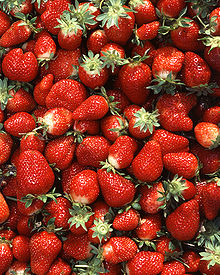 Fragaria × ananassa 'Chandler,' a short-day commercial cultivar grown in California
Fragaria × ananassa 'Chandler,' a short-day commercial cultivar grown in California
World strawberry production in tonnes[21] Country 2005 2006 2007 2008 Egypt 100,000 100,000 104,000 200,254 Germany 146,500 173,230 158,658 150,854 Italy 146,769 131,305 57,670 155,583 Japan 196,200 190,700 193,000 Mexico 162,627 191,843 176,396 207,485 Morocco 118,600 112,000 100,000 130,000 Poland 184,627 193,666 174,578 200,723 Russia 221,000 227,000 230,400 145,000 Korea, South 201,995 205,307 203,227 Spain 320,853 333,485 263,900 Turkey 200,000 211,127 250,316 261,078 United Kingdom 68,600 73,900 87,200 Guatemala 24,900 54,300 61,700 USA 1,053,242 1,090,436 1,133,703 1,148,530 Total world 3,782,906 3,917,140 3,824,678 4,068,454 Agronomy
A diorama created from beeswax by Dr. Henry Brainerd Wright at the Louisiana State Exhibit Museum in Shreveport, Louisiana depicts strawberry harvesting. Strawberries are particularly grown in the southeastern portion of the state about Hammond.
Strawberries are an easy plant to grow, and can be grown almost anywhere in the world. The best thing to do is to buy a plant in early to middle spring. Place the plant preferably in full sun, and in somewhat sandy soil. Strawberries are a strong plant that will survive many conditions, but, during the time that the plant is forming fruit, it is important for it to get enough water. Strawberries can also be grown as a potted plant, and will still produce fruit.
A strawberry plant will send out shoots in an attempt to propagate a new plant, and, if left alone, it will be successful in doing so, but this shoot can be cut off, and placed wherever you wish to start a new plant.
Uses
In addition to being consumed fresh, strawberries can be frozen, made into preserves, as well as dried and used in such things as cereal bars. Strawberries are a popular addition to dairy products, as in strawberry-flavored ice cream, milkshakes, smoothies, and yogurts. Strawberries and cream is a popular dessert, famously consumed at Wimbledon. Depending on area, strawberry pie, strawberry-rhubarb pie, or strawberry shortcake are also popular.
Strawberry pigment extract can be used as a natural acid/base indicator due to the different color of the conjugate acid and conjugate base of the pigment.[22]
Strawberries contain fisetin, an antioxidant that has been studied in relation to Alzheimer's disease and to kidney failure resulting from diabetes.[23]
Nutrition
One cup (144 g) of strawberries contains approximately 45 calories (188 kJ) and is an excellent source of vitamin C and flavonoids.[24][25][26]
Category Nutrient Units 1 cup (144 g) whole Proximates Water g 132 Energy kcal 43 Energy kJ 181 Protein g 0.88 Total lipid (fat) 0.53 Carbohydrate, by difference 10.1 Fiber, total dietary 3.3 Ash 0.62 Minerals Calcium mg 20 Iron 0.55 Magnesium 14 Phosphorus 27 Potassium 240 Sodium 1.44 Zinc 0.19 Copper 0.07 Manganese 0.42 Selenium µg 1.01 Vitamins Vitamin C, ascorbic acid mg 82 Thiamin 0.03 Riboflavin 0.1 Niacin 0.33 Pantothenic acid 0.49 Vitamin B-6 0.09 Folate µg 25 Vitamin B-12 µg 0 Vitamin A, IU IU 39 Vitamin A, RE µg RE 4.3 Vitamin E mg ATE 0.20 Lipids Fatty acids, saturated g 0.03 16:0 0.02 18:0 0.006 Fatty acids, monounsaturated 0.075 16:1 0.001 18:1 0.073 Fatty acids, polyunsaturated 0.27 18:2 0.16 18:3 0.11 Cholesterol mg 0 Phytosterols 17 Amino acids Tryptophan g 0.01 Threonine 0.027 Isoleucine 0.02 Leucine 0.045 Lysine 0.036 Methionine 0.001 Cystine 0.007 Phenylalanine 0.026 Tyrosine 0.030 Valine 0.026 Arginine 0.037 Histidine 0.017 Alanine 0.045 Aspartic acid 0.20 Glutamic acid 0.13 Glycine 0.035 Proline 0.027 Serine 0.033 Allergy
Some people experience an anaphylactoid reaction to the consumption of strawberries.[27] The most common form of this reaction is oral allergy syndrome, but symptoms may also mimic hay fever or include dermatitis or hives, and, in severe cases, may cause breathing problems. Some research suggests that the allergen may be tied to a protein involved in the ripening of fruits, which was named Fra a1 (Fragaria allergen1). Homologous proteins are found in birch and apple, which suggests that people may develop cross-reactivity to all three species.
White-fruited strawberry cultivars, lacking Fra a1, may be an option for strawberry allergy sufferers. Since they lack a protein necessary for normal ripening, they do not produce the flavonoids that turn the mature berries of other cultivars red. They ripen but remain white, pale yellow or "golden", appearing like immature berries; this also has the advantage of making them less attractive to birds. A virtually allergen-free cultivar named 'Sofar' is available.[28][29]
Gallery
See also
- California Strawberry Commission
- Fragaria vesca (alpine strawberry)
- Fraise Tagada (strawberry-shaped candy popular in France)
- List of strawberry cultivars
- Musk Strawberry (hautbois strawberry)
- Plant City, Florida (winter strawberry capital of the world)
References
- ^ "Strawberry, The Maiden With Runners". Botgard.ucla.edu. http://www.botgard.ucla.edu/html/botanytextbooks/economicbotany/Fragaria/index.html. Retrieved 2009-12-05.
- ^ "Strawberries by Martin Welsh, history, variety and cultivation of strawberries". Nvsuk.org.uk. http://www.nvsuk.org.uk/growing_show_vegetables_1/strawberry.php. Retrieved 2009-12-05.
- ^ a b c Esau, K. 1977. Anatomy of seed plants. John Wiley and Sons, New York.
- ^ a b "G6135 Home Fruit Production: Strawberry Cultivars and Their Culture | University of Missouri Extension". Extension.missouri.edu. http://extension.missouri.edu/publications/DisplayPub.aspx?P=G6135. Retrieved 2009-12-05.
- ^ Strawberry Growing, Stevenson Whitcomb Fletcher, The Macmillan Co., New York, 1917. Google Books
- ^ a b c d "Strawberry Plasticulture Offers Sweet Rewards". Ag.ohio-state.edu. 2002-06-28. http://www.ag.ohio-state.edu/~news/story.php?id=2126. Retrieved 2009-12-05.
- ^ a b c d Newenglandvfc.org
- ^ "Pritts Greenhouse Berried Treasures". Hort.cornell.edu. http://www.hort.cornell.edu/department/faculty/pritts/grnhouse.html. Retrieved 2009-12-05.
- ^ a b c "Strawberry Fields Forever". Noble.org. http://www.noble.org/Ag/Horticulture/StrawberryFields/index.html. Retrieved 2009-12-05.
- ^ Wang SW., Millner P. (November 2009). "Effect of Different Cultural Systems on Antioxidant Capacity, Phenolic Content, and Fruit Quality of Strawberries (Fragaria × aranassa Duch.)". Journal of Agricultural and Food Chemistry (ACS Publications) 57 (20): 9651–9657. doi:10.1021/jf9020575. http://pubs.acs.org/doi/abs/10.1021/jf9020575.
- ^ Wang SY, Lin HS (November 2003). "Compost as a soil supplement increases the level of antioxidant compounds and oxygen radical absorbance capacity in strawberries". Journal of Agricultural and Food Chemistry 51 (23): 6844–50. doi:10.1021/jf030196x. PMID 14582984.
- ^ a b "Proper Cultivation Yields Strawberry Fields Forever". Larrysagers.com. 1992-04-15. http://www.larrysagers.com/weeklyarticles/proper_cultivation_yields_strawberry_fields_forever_92-04-15.html. Retrieved 2009-12-05.[dead link]
- ^ S. C. Hokanson, J. L. Maas, 2001. Strawberry biotechnology, Plant Breeding Reviews 21:139–179
- ^ "Journal Article". SpringerLink. http://www.springerlink.com/content/h7836v248q76740r/. Retrieved 2009-12-05.
- ^ "HS1116/HS370: Nitrogen Fertilization of Strawberry Cultivars: Is Preplant Starter Fertilizer Needed?". Edis.ifas.ufl.edu. 2007-08-06. http://edis.ifas.ufl.edu/document_hs370. Retrieved 2009-12-05.
- ^ a b "Commercial Postharvest Handling of Strawberries (Fragaria spp.)". Extension.umn.edu. http://www.extension.umn.edu/distribution/horticulture/DG6237.html. Retrieved 2009-12-05.
- ^ "Conveyors improve the fruits of processor's labors.(Frexport S.A. de C.V.)". AccessMyLibrary. 2000-01-01. http://www.accessmylibrary.com/coms2/summary_0286-5729041_ITM. Retrieved 2009-12-05.
- ^ a b "Insect Pests of Strawberries and Their Management". Virginiafruit.ento.vt.edu. 2000-05-03. http://www.virginiafruit.ento.vt.edu/StrawMaster.html. Retrieved 2009-12-05.
- ^ "Radcliffe's IPM World Textbook | CFANS | University of Minnesota". Ipmworld.umn.edu. 2009-11-20. http://ipmworld.umn.edu/chapters/rao.htm. Retrieved 2009-12-05.
- ^ a b c d e "Strawberry Diseases". Extension.umn.edu. http://www.extension.umn.edu/distribution/horticulture/DG1148.html. Retrieved 2009-12-05.
- ^ FAO stat
- ^ Alameda.peralta.edu
- ^ Pamela Maher and David Schubert, et al. Fisetin Lowers Methylglyoxal Dependent Protein Glycation and Limits the Complications of Diabetes; PLoS One 1; June 2011, 6, 6, -e 21226. http://www.plosone.org/article/info%3Adoi%2F10.1371%2Fjournal.pone.0021226
- ^ "Nutrition Facts and Analysis for Strawberries, raw". Nutritiondata.com. http://www.nutritiondata.com/facts/fruits-and-fruit-juices/2064/2. Retrieved 2009-12-05.
- ^ BonkeurInternet. "Strawberry Nutrition Facts. Health, Food, Diet". Thefruitpages.com. http://www.thefruitpages.com/chartstrawberries.shtml. Retrieved 2009-12-05.
- ^ "Strawberry Nutrition". Sweetdarling.com. 1997-07-14. http://www.sweetdarling.com/lfiapp/Nutritional.cfm. Retrieved 2009-12-05.
- ^ Robinson, Kerry. "Food Safety, Healthy Eating and Nutrition Information". IFIC. http://www.ific.org/foodinsight/2003/ja/foodsensfi403.cfm. Retrieved 2009-12-05.
- ^ Hjernø K, Alm R, Canbäck B, et al. (March 2006). "Down-regulation of the strawberry Bet v 1-homologous allergen in concert with the flavonoid biosynthesis pathway in colorless strawberry mutant". Proteomics 6 (5): 1574–87. doi:10.1002/pmic.200500469. PMID 16447153.
- ^ The chemistry of strawberry allergy (includes 'Sofar' reference)
External links
Categories:- Fragaria
- Accessory fruit
- Berries
- Hybrid fruit
Wikimedia Foundation. 2010.

